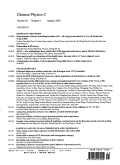- 钛学术文献服务平台 \
- 学术期刊 \
- 基础科学期刊 \
- 物理学期刊 \
- 中国物理C(英文版)期刊 \
null
PLOTS OF CROSS SECTIONS AND RELATED QUANTITIES
基本信息来源于合作网站,原文需代理用户跳转至来源网站获取
摘要:
Figure 50.1:Inclusive differential jet cross sections,in the central rapidity region,plotted as a function of the jet transverse momentum.Results earlier than from the Tevatron Run 2 used transverse energy rather than transverse momentum and pseudo-rapidity η rather than rapidity y,but pT and y are used for all results shown here for simplicity.The error bars plotted are in most cases the experimental stat.and syst.errors added in quadrature.The CDF and D0 measurements use jet sizes of 0.7 (JetClu for CDF Run 1,and Midpoint and kT for CDF Run 2,a cone algorithm for D0 in Run 1 and the Midpoint algorithm in Run 2).The ATLAS results are plotted for the antikT algorithm for R=0.4,while the CMS results also use antikT,but with R=0.5.NLO QCD predictions in general provide a good description of the Tevatron and LHC data;the Tevatron jet data in fact are crucial components of global PDF fits,and the LHC data are starting to be used as well.Comparisons with the older cross sections are more difficult due to the nature of the jet algorithms used.ATLAS:Phys.Rev.D86,014022 (2012),Eur.Phys.J C73,2509 (2013);CMS:Phys.Rev.D84,052011 (2011);CDF:Phys.Rev.D75,092006 (2007),Phys.Rev.D64,032001 (2001),Phys.Rev.Lett.70,1376 (1993);D0:Phys.Rev.D64,032003 (2001);UA2:Phys.Lett.B257,232 (1991);UA1:Phys.Lett.172,461 (1986);R807:Phys.Lett.B123,133 (1983).(Courtesy of J.Huston,Michigan State University,2013.)

推荐文章
期刊_丙丁烷TDLAS测量系统的吸收峰自动检测
带间级联激光器
调谐半导体激光吸收光谱
雾剂检漏 中红外吸收峰 洛伦兹光谱线型
不同盐度、温度及光照对漂浮浒苔生理生态的影响
浒苔
盐度
温度
光照
生理生态
期刊_联合空间信息的改进低秩稀疏矩阵分解的高光谱异常目标检测
高光谱图像
异常目标检测 低秩稀疏矩阵分解 稀疏矩阵 残差矩阵
内容分析
关键词云
关键词热度
相关文献总数
(/次)
(/年)
文献信息
| 篇名 | PLOTS OF CROSS SECTIONS AND RELATED QUANTITIES | ||
| 来源期刊 | 中国物理C(英文版) | 学科 | |
| 关键词 | |||
| 年,卷(期) | 2014,(9) | 所属期刊栏目 | |
| 研究方向 | 页码范围 | 530-544 | |
| 页数 | 15页 | 分类号 | |
| 字数 | 语种 | 中文 | |
| DOI | |||
五维指标
引文网络
引文网络
二级参考文献 (0)
共引文献 (0)
参考文献 (0)
节点文献
引证文献 (0)
同被引文献 (0)
二级引证文献 (0)
2014(0)
- 参考文献(0)
- 二级参考文献(0)
- 引证文献(0)
- 二级引证文献(0)
引文网络交叉学科
相关学者/机构
期刊影响力
中国物理C(英文版)
主办单位:
中国物理学会
中国科学院高能物理研究所
中国科学院近代物理研究所
出版周期:
月刊
ISSN:
1674-1137
CN:
11-5641/O4
开本:
出版地:
北京市玉泉路19号(乙)中国科学院高能物理研究所内 北京918信箱
邮发代号:
创刊时间:
语种:
eng
出版文献量(篇)
3629
总下载数(次)
0
总被引数(次)
2764
期刊文献
相关文献
推荐文献
- 期刊分类
- 期刊(年)
- 期刊(期)
- 期刊推荐
力学
化学
地球物理学
地质学
基础科学综合
大学学报
天文学
天文学、地球科学
数学
气象学
海洋学
物理学
生物学
生物科学
自然地理学和测绘学
自然科学总论
自然科学理论与方法
资源科学
非线性科学与系统科学
中国物理C(英文版)2022
中国物理C(英文版)2021
中国物理C(英文版)2020
中国物理C(英文版)2019
中国物理C(英文版)2018
中国物理C(英文版)2017
中国物理C(英文版)2016
中国物理C(英文版)2015
中国物理C(英文版)2014
中国物理C(英文版)2013
中国物理C(英文版)2012
中国物理C(英文版)2011
中国物理C(英文版)2010
中国物理C(英文版)2009
中国物理C(英文版)2008
中国物理C(英文版)2014年第9期
中国物理C(英文版)2014年第8期
中国物理C(英文版)2014年第7期
中国物理C(英文版)2014年第6期
中国物理C(英文版)2014年第5期
中国物理C(英文版)2014年第4期
中国物理C(英文版)2014年第3期
中国物理C(英文版)2014年第2期
中国物理C(英文版)2014年第12期
中国物理C(英文版)2014年第11期
中国物理C(英文版)2014年第10期
中国物理C(英文版)2014年第1期

 免费查重
免费查重










